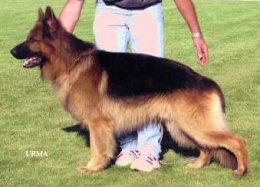What is a "long-haired" shepherd? Where does he come from?
We hear these questions whenever we walk our beautiful dogs and meet people from other
countries to whom these dogs are unknown.
Here is the history of these dogs:
The long-haired shepherd is actually the ancestor of the "short-hair."
Before 1899, two kinds of shepherds were found in Germany, one with longer hair than
the other. Both kinds of were generally used for sheep work. A person named Rittmeister
von Stephanitz recognized the intelligence of these dogs. He strongly believed that
they could be used for other tasks, and had an idea of how to enhance their body structure
to turn them into all-around working dogs. At the same time, he believed that the coat
of these new working dogs should be relatively short.
In 1899, he founded the "SV" Club - the world-famous "Schäferhund-Verein."
Thus, the breed-standard for the German shepherd was set. Later on the F.C.I and VDH
accepted this standard.
Unfortunately, in this standard the "long-hair" was considered
undesirable and was no longer accepted in the breed, in the mistaken belief that the
"long-hair" did not have an undercoat.
Even after many years of careful breeding, occasionally a few "long-hair"
puppies are still born into a "short-hair" litter. This is usually an indication
that the whole litter is a good one because the sires and dams who have produced it
are carriers of the strong genes of their ancestors. Generally, the puppies with this
gene have a strong-boned body structure, are exceptionally good-natured, and are of
sound character.

In the sixties and seventies, not many "long-hair" shepherds
were seen on the streets. The breeders of "short-hairs" quietly gave them
away to people who wanted a family dog and were not interested in breeding. But more
and more people began to keep "long-hairs" as pets. Some who used these pets
as working dogs soon recognized that their "long-hair's" Schutzhund ability
was as good as any "short-hair's."These appreciative owners did not want
the "long-hair" breed to die out.
In 1984, a small group of people gathered to found the LSVD e.V. Club
(Langstockhaar Schäferhundeverein Deuschland e.V.), the "long-hair shepherd
club Deutschland." This club laid down strict breeding regulations, hoping to
be recognized by the VDH, F.C.I., and SV. In 1991, their petitions were denied. No
recognition came from the VDH, the F.C.I., or the SV.
The ASVD, a second "long-hair" club, was founded in 1989. A few years later, the LSGS, a third "long-hair" club, was founded in Switzerland. Membership in these clubs is growing rapidly. Their goal is to make the "long-hair" shepherd more popular.
In the late 1990s, Horst Hegewald-Kawich wrote a book titled "Ratgeber Langhaar-Schäferhund." In it, he states the important fact that the "long-hairs," like their "short-hair" brothers, do have thick undercoats and can be used as working dogs all over the world, as well as in sport-competitions such as obedience, tracking, schutzhund and agility.
Here in Germany, the LSVD, ASVD, and LSGS have their own shows.
Dogs selected for breeding have to pass at least one obedience test and must be presented
to a breeding committee, which tests them for sound temperament. Their hips must be
x-rayed and only dogs with no sign of dysphlasia may be used for breeding. Since 2004,
the ASVD requires that elbows (ED) must also be x-rayed.
Purchasing a "short-hair" German shepherd from good stock
may cost thousands of dollars, whereas a "long-hair" puppy from the identical
litter, or from the same bloodline and bred through the LSVD, ASVD, or LSGS Clubs,
cannot be sold for comparative prices merely because the SV does not recognize the
breed. People familiar with the "long-hair's" admirable qualities want him
for his beautiful looks, his intelligence, and his sound character.
Over the past seven years, many of these people have come to our house
and left passionate about our outstanding animals.
Copyright by Dagmar Anderson 2003